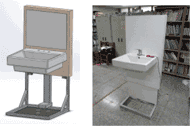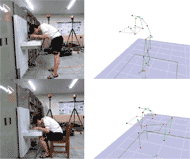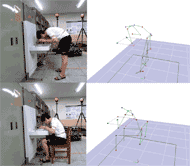Ju-Hwan Bae and Inhyuk Moon
Department of Mechatronics Engineering, Dong-Eui University, Busan, Korea
INTRODUCTION
According to a statistics of safety accident in older adults(Korea Consumer Agency, 2011), most of accidents occurred at home as 57.2%, but the accidents at public service facility such as public spa and subway station were 14.7%, and 9.8% was on the roads. Particularly the accident rate in the restroom or bathroom at home was 15.6%, which was higher than that of falling accident on stairs with 12.2%. The survey result of elderly persons showed that restrooms and bathrooms were the most inconvenient spaces (26.2%) and the most dangerous spaces (34.2%) at home.
In 2010, the Ministry of Land, Infrastructure and Transport (MOLIT) of Korea revised the guideline of home construction for persons with disability: facilities such as showers, sinks, and height-adjustable wash basin, and removing obstacles like doorsill. At least 5% of total homes in public housing (BOGUMZARI) is obligated to be designed barrier-free based on the guideline.
Wash basin is classified as a division of the class assistive product for personal care and protection in ISO 9999(International Organization for Standardization, 2011). In Korean Standard (KS) we can find out a standard concerning wash basin, but it just describes requirements and test methods for a general wash basin not for the persons with disability(International Organization for Standardization, 2011). There are various demands for assistive products in daily living because the body function and activity ability of persons with disability are quite different individually. In 2012 ISO TC173 concerning assistive products organized a new working group, WG9, so as to fix a standard on assistive products for personal hygiene. However WG9 excluded wash basin from scope of WG9.
In this paper we propose a design guideline of height-adjustable wash basin based on anthropometric data of Korean called SizeKorea(Korea Agency for Technology and Standards, 2010) and motion analysis results. Then we perform a verification test of the guideline using a prototype height-adjustable wash basin developed based on the guideline. From the results of a series of tests it is shown that the design guideline proposed in this paper can be applicable to a standard for the height-adjustable wash basin.
METHODS
There are many factors composed of design guideline: range of height adjustment, requirements of safety and performance of height-adjustable function, shape of wash basin, and so on. This paper deals with a design guideline focusing on the height-adjustable function. Experiments to determine the range of height adjustment was performed based on the anthropometric data aged 60 to 70 years old. Experimental procedure is set to four steps as follows:
- The initial height of height-adjustable wash basin is set to the average of elbow height.
- Subject performs a posture washing his face with standing.
- Then, 3D motion capture system measures bending angles of body and neck.
- Moment force on lumbar is estimated using human body model shown in Fig. 2 and subject’s body data.
We applied the same procedure to tests for wheelchair users except the 1st step; it is set to the average of elbow height when subject seated because wheelchair user is seated normally. In step 3, we used 6 high-speed IR cameras to detect 30 makers attached on subject’s body. In step 4, the moment force on lumbar is calculated as the following equation(Kwon, Y.G., & Byeon, S.N., 1999).
M![]() j = M
j = M![]() j-1+(L
j-1+(L![]() j cos θ
j cos θ![]() j W
j W![]() L)+(D
L)+(D![]() j*j-1 cos θ
j*j-1 cos θ![]() j R
j R![]() j-1), (1)
j-1), (1)
where M![]() j is reactive load moment of joint j, L
j is reactive load moment of joint j, L![]() j is distance between joint j to the center of mass of link L,
j is distance between joint j to the center of mass of link L, ![]() is posture angle of link L of joint j,
is posture angle of link L of joint j, ![]() is weight of link L, and
is weight of link L, and ![]() is length of joint j to adjacent link j-1.
is length of joint j to adjacent link j-1. ![]() is reactive force on the adjacent joint j-1. The mass, length and density of specific body were estimated based on Winter’s book(Winter, D.A., 2005).
is reactive force on the adjacent joint j-1. The mass, length and density of specific body were estimated based on Winter’s book(Winter, D.A., 2005).
|
avg |
Height |
1578.4 |
Flexed elbow height |
964.9 |
Elbow height seated |
237.2 |
Knee height seated |
474.2 |
PRELIMINARY EXPERIMENTS
Experimental setup
In experiments we used average data of age 60 to 70 years old in the SizeKorea DB (see Table 1), and five subjects over 65 years old (all male, age 68.6±4.3yrs., height 169.8±5.7cm, weight 70±7.7kg) participated in the experiments.
We first set two different initial heights of wash basin to 964[mm] and 872[mm] in order to compare the height effects to lumbar moment. When subject performs a posture washing his face with standing or seated, 3D motion capture system measures bending angles of body and neck and then the lumber moment is estimated. Fig. 3 shows examples measuring body postures by the motion capture system.
Table 2 shows the experimental results of five subjects. Lower position of wash basin made subject to bend his upper body, so higher moment loaded on subject’s lumbar. It was proportional to the gap of elbow and wash basin.
| A | B | C | D | E | |
|---|---|---|---|---|---|
| Elbow height [mm] | 1123 | 1216 | 1230 | 1222 | 1156 |
| Moment [Ncm] (964mm set) | 110.1 | 136.3 | 123.2 | 146.0 | 95.4 |
| Moment [Ncm] (872mm set) | 123.5 | 159.0 | 132.2 | 153.9 | 101.7 |
| A | B | C | D | E | |
|---|---|---|---|---|---|
| Elbow height [mm] | 817 | 828 | 863 | 850 | 846 |
| Moment [Ncm] (800mm set) | 93.5 | 114.1 | 87.3 | 106.5 | 81.8 |
| Moment [Ncm] (704mm set) | 87.3 | 125.2 | 92.1 | 106.5 | 84.5 |
Next we performed face washing motion with seated and set the initial heights of wash basin to 800[mm] and 740[mm]. The experimental results in Table 3 show the same results as Table 2 except subject A. As the measured results, the bending angles of neck and lumbar were -29.6 [deg] and 57.6 [deg] at the high position, but at the low position they were -13.5 [deg] and 60.9 [deg] respectively. This means the subject moved up his neck to the upright position even though wash basin went down.
Results
From the results of two experiments, the lumbar moment is highly concerned with the height of wash basin; the lower position leads a wide gap between elbow and wash basin, consequently user should bend his upper body to the front side. This is the main cause of increasing lumbar moment. Accordingly, it is essential to fit the height of wash basin to the elbow position of SizeKorea data.
DESIGN GUIDELINE
Requirements of design
First, the height of wash basin should not be higher than the flexed elbow position because the higher position would interfere with arm movements. Considering wheelchair users, the wash basin should not be lower than knee position of wheelchair user because the knee of wheelchair user is normally placed under the wash basin. Using the SizeKorea data, we set 1116[mm] corresponding to the maximum height of flexed elbow to the maximum height of wash basin. The minimum height depends on the elbow height with seated. Moreover we should consider the height of chair. With these considerations, we set the minimum height to 652 [mm], which is the value summing the height of chair, 500[mm], to the minimum of elbow height with seated, 152[mm]. Because the minimum height of knew with seated is 386 [mm], the thickness of wash basin should be less than 260 [mm]. Table 4 and Fig. 4 are the design guideline for height-adjustable wash basin.
| Min H. (a) | Max H. (b) | Thick. (c) | Depth (d) | |
|---|---|---|---|---|
Length [mm] |
≥652 |
≤1116 |
≤260 |
≤262 |
| Min H. (a) | Max H. (b) | Thick. (c) | Depth (d) | |
|---|---|---|---|---|
Length [mm] |
650 |
1110 |
180 |
260 |
EXPERIMENTS
Prototype
We developed a prototype height-adjustable wash basin based on the design guideline in Table 4. The function of height adjustment was implanted by a linear actuator (LA31, Linak Co.) whose motion stroke and waterproof level are 450mm and IPx4, respectively. The whole size of the prototype is 500x600x1200 [mm], and the designed each components are shown in Table 5. Fig. 5 shows the developed prototype whose size of wash basin is 450x500x180 [mm].
Verification test
The purpose of this experiment is to verify a possibility of the design guideline. We first set the flexed elbow height with standing and with seated to the initial height of the prototype wash basin, and then compare to a conventional wash basin fixed in the restroom with 750mm. The experiment is performed with one subject (male, 24 yrs., 75kg, 176cm). The heights of flexed elbow of the subject are 1010mm with standing and 660mm with seated.
Fig. 6 shows the results of motion capture when the subject performed face washing motion with standing.
As the results, the lumbar moment with standing was 801kgfcm at the height of the flexed elbow joint and 1178kgfcm at the fixed conventional height. The height-adjustable wash basin showed less lumbar moment. However, when the subject was seated, the lumbar moment was 922kgfcm at the flexed elbow joint and 627kgfcm at the fixed conventional height respectively. This means that the high position is less lumbar moment, but relatively high position than the height of flexed elbow joint may be uncomfortable for the wheelchair user to perform washing motion.
CONCLUSIONS
In this paper we proposed a design guideline of height-adjustable wash basin based on anthropometric data of Korean. Using human model, we analyzed the lumbar motion when subject performed face washing motion. From the experimental results, we proposed a design guideline. Then we performed a verification test of the guideline using a prototype height-adjustable wash basin developed based on the guideline, and compared with a conventional wash basin with fixed height. As the result, the height-adjustable wash basin is more useful for persons with disability. To test with more subjects is the near future work.
REFERENCES
Reports by Korea Consumer Agency (2011). Retrieved from http://www.kca.go.kr.
International Organization for Standardization (2011). ISO 9999:2011, Assistive products for persons with disability – Classification and terminology.
International Organization for Standardization (2013). ISO/CD 17966: Assistive products for personal hygiene that support users — Requirements and test methods.
Korea Agency for Technology and Standards (2010). 6th report of Korean human body measurement database, Retrieved from http://sizekorea.kats.go.kr
Kwon, Y.G., & Byeon, S.N. (1999). Novel Biomechanics (Korean), Cheongmunkak.
Winter, D.A. (2005). Biomechanics and Motor Control of Human Movement, (3rd ed.). John Wiley & Sons.
Audio Version PDF Version






